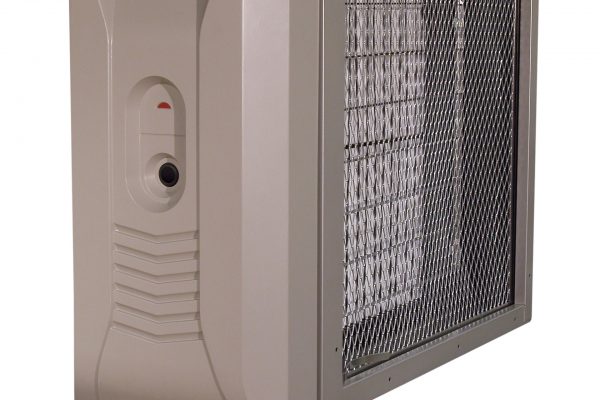Many people overlook the importance of air filtration when considering indoor air quality (IAQ). A proper HVAC system should have a filter as part of the system. The air filters job in the HVAC system is to keep the units clean and help to avoid breakdowns caused by dirt and debris. Without a filter, the HVAC system may have problems draining water away as dirt gets trapped in the drain. There may be indoor coil issues that arise as unfiltered air blows across the wet coils and dirt and debris get stuck in the condensate and stick to the coil. The same problem applies to ductwork as the dirty air travels past the unit and into the ductwork. The dirty air catches in the ductwork and can cause improper airflow. In each case, water can be trapped and this in turn might allow mold and other allergens to grow and flourish. Even the most basic filter is better than no filter, not only your HVAC system but for your family in residential settings and employees in commercial settings. In 2018, Miami Valley residents used their heating and cooling systems a lot. In fact, according to Wunderground, we had 178 days with temperature highs below 60° and 108 days with temperature highs over 80° F. Meaning, most people used their HVAC systems over 75% of the year! That is a lot of time your filter is being used.
The U.S. Environmental Protection Agency describes indoor air pollution as one of the top five environmental health risks. For people with allergies, scientific studies have shown that air filtration reduces these airborne allergens and may provide some relief.
The World Health Organization has provided recommended standards covering three ranges of particle sizes, specifying guidelines for acceptable particulate matter concentrations. The human eye can only see particles as small as 25 to 60 microns – or the diameter of a human hair – but the particles that are most dangerous to human health are significantly smaller and invisible to the human eye (PM 2.5 and PM 1).
Minimum Efficiency Reporting Value (MERV) rating is determined by measuring particle counts upstream and downstream of the air-cleaning device being tested, the more particles removed by the filter, the higher the MERV rating. There are 12 particle sizes being tested. Dust spot efficiency is used to show how effective is at filtering smaller particle atmospheric dust from the air. Arrestance is the ability to filter to remove larger particles of dust. A High Efficiency Particulate Air (HEPA) filter can accomplish over 99.97% arrestance of these finer air particles.
CAUTION: As the MERV rating goes up it can affect the performance of your HVAC system. Adding a 15MERV filter to a system that was designed for 4 MERV increases resistance. The blower in the furnace or air handler is rated for a certain amount of pressure drop and increasing resistance increases the pressure drop which may cause reduced airflow throughout the system leading to reduced filtration, reduced comfort, the air conditioning coil to freeze up, and even the furnace heat exchanger to crack. Make sure your system is able to accept a higher MERV rated filter before installing. When considering replacing a HVAC system or just the filtration make sure a professional considers and verifies the system operation is correct.
-
Flat Filters
- Basic level of protection for HVAC components.
-
Extended Media Filters
- Layered, thicker.
-
Electronic Air Cleaning
- Electric charge to clean the air.
-
1-4 MERV
- Setting for use: Standard Residential and Standard Light Commercial
- Effectiveness: Use for up to 80% of larger particles and under 20% of smaller particles filtered
- Examples of particles filtered effectively: Sanding dust, spray paint dust, and carpet fibers
- Common filter types in this range: flat-panel fiberglass and washable/reusable
-
5-7 MERV
- Setting For Use: Good Residential, Better Light Commercial, Industrial Workplaces
- Effectiveness: Up to 90% of larger particles and up to 30% of smaller particles filtered.
- Examples of particles filtered effectively: Pollen, pet dander, and hair spray
- Common filter types in this range: 1-2” cotton pleated and flat-panel fiberglass
-
8-12 MERV
- Setting for Use: Superior Residential, Good Light Commercial, Commercial, Good Industrial Workplaces
- Effectiveness: Up to 95% of larger particles and up to 75% of smaller particles filtered
- Examples of particles filtered effectively: Welding fumes, auto emissions, milled flour, lead dust, pollen, household dust, lint, mold spores, Legionella, and dust mites
- Common filter types in this range: 1-2” cotton pleated, media panel filter, and extended surface deep pleated
-
13-16 MERV
- Setting for Use: Hospitals and Health Care Facilities, Superior Residential, Superior Commercial, Superior Industrial Workplaces
- Effectiveness: Greater than 95% of larger particles and greater than 98% of smaller particles filtered.
- Examples of particles filtered effectively: Tobacco smoke, general smoke, all bacteria, Droplet Nuclei (sneeze), cooking oil, smog, virus carriers.
- Common filter types in this range: Media panel filter, extended surface deep pleated
-
17-20 MERV
- Setting for Use: Specific Commercial Applications; Cleanrooms, Radioactive Materials, Pharmaceuticals, Carcinogenetic Materials
- Effectiveness: 100% of larger particles and 99.97% or greater of smaller particles filtered.
- Examples of particles filtered effectively: All combustion smoke, carbon dust, viruses
- Common filter types in this range: Fiberglass and nonwoven fabric material
When it comes to comfort and air filtration, a proper analysis by an advisor needs to be made. Many factors come into play such as: what type of building is it, does anyone have any allergies, does anyone have a weak immune system, and can the MERV be increased without compromising the airflow? Other factors that play a role in comfort are cost of installation and the cost of replacement filters.
Did you know?
- 50% of all illnesses are caused or aggravated by poor indoor air quality according to The American College of Allergy, Asthma & Immunology. A study cited by Kimberly-Clark Corporation found that for every 10 workers, poor indoor air quality caused an additional 6 sick days per year.
- The U.S. Department of Energy (DOE) states poor indoor air quality can cost businesses up to $168 billion annually. Medical care and absenteeism contribute significantly to those costs.
- Employers can increase workforce performance by roughly 10 % by implementing indoor air quality solutions – DOE.
- By controlling contaminants such as dust mites, asthma cases can be reduced by 55 to 60% – The American Journal of Respiratory and Critical Care Medicine.
Using an air filter is just one step toward improving the overall quality of indoor treated air. Here are some other things you can do to help IAQ:
- Do not smoke in the building
- Use a vacuum cleaner with a HEPA filter to reduce dust, dander, and other allergens
- Keep humidity in your home below 50% year round
- If you have a pet, groom the pet outside the home to reduce the amount of pet dander in the air.
- If you have tiled floors or walls, make sure to they are kept clean to reduce the potential for mold growth.
- Check and/or change your filter regularly, check at least once a month, if you have pets, once every two weeks.
- Use Zero and Low VOC paint indoors
- Spray paint in garage or outdoors
- Plants, natural air purifiers, but beware if you suffer from allergies, they may hurt more than help.
- Candles, limit use or use beeswax candles, which let off less smoke.
- Professional carpet cleaning, they can treat for pets and allergens in the carpet as well.
- Make sure to turn on the exhaust when you are cooking, this can greatly reduce oil and smoke.
Make sure to check and/or change the filter regularly, with pets every two weeks, no pets, check once am month
At Hauck Bros., Inc., our Gold and Platinum Home Comfort Protection Plans come with Media Filter replacement included in the plan at the time of the maintenance inspection. Media Filter Replacement can also be added to the Silver plan for as low as $7 per month.
Accessories
Thermostat, Some models have maintenance features that will remind you to check/replace the filter
Ionizer, uses high voltage to ionize (electrically charge) air molecules. Negative ions, or anions, are particles with one or more extra electron, conferring a net negative charge to the particle. Effective against other particles normally reserved for a higher MERV count. Examples, viruses, bacteria, mod spores, and smoke.
Ultraviolet (UV) Light, designed to help eliminate mold, bacteria, viruses, and other allergens that can be circulated in the air.
-
Flat Filters
- Once a month
-
Extended
- Once a year
-
Electronic
- Once a month
- *Cleaned, not replaced
- Part of our Gold Home Comfort Protection Plan, starting at $32.50 a month, we follow the Energy Star™ maintenance checklist. This includes changing your air filter in your HVAC system. A dirty filter can increase energy costs and damage your HVAC system.
- According to the U.S. Department of Energy, not changing your filter regularly can lower your central air conditioner efficiency by 5-15%.
- A MERV Rating of 1 means the filter will catch textile fibers, 2 Spray Piant dust, 3 Dust Mites, 4 Pollen, 5 Pudding Mix, 6 Fabric Protector Spray, 7 Hair Spray, 8 Mold spores, 9 Welding Fumes, 10 Auto Emissions, 11 Lead dust, 12 Legionella, 13 Proplet Nuceli (sneeze), 14 most Tobacco Smoke, 15 All Bacteria, 16 95% of all household particles. 17 and above MERV are HEPA approved which means they remove 99.97% of all airborne particles. However, The higher the MERV the more air it may block to the HVAC system. Please make sure to talk to us before upgrading your MERV rated filter.
- Looking for another way to improve your air filtration without upgrading your air filter. Air Ionizers and Ultraviolet lights can both reduce mold, bacteria, odors, and reduce airborne particles in your HVAC system ductwork without worrying about your airflow. They can also be added to most Ductless HVAC systems as well!
Filters we carry
- Fiberglass Filter, MERV 3-4
- Standard Capacity Pleated Panel Filter, MERV 8
- Upgraded High Capacity Pleated Panel Filter, MERV 8
- Bryant ® EZ-Flex MERV 10 Media Air Cleaner
- Honeywell PopUP MERV 11 Media Air Cleaner
- Electronic Air Filter, MERV 15
- HEPA Filters
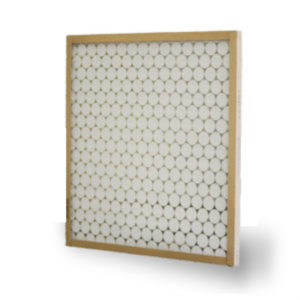
Filter changes: Recommend changing the filter at least once per month.
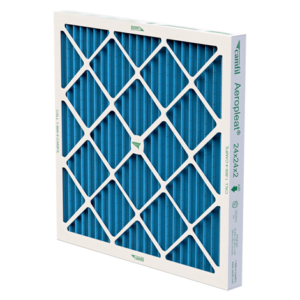
- The Aeropleat III has 10 pleats per linear foot (2” deep model) with a radial pleat design for full use of media area
- A cotton and synthetic media blend which provides medium grade ASHRAE performance and high dust-holding capacity.
- Includes a welded wire media grid that is treated for corrosion resistance and prevents media oscillation or pull-away. The wire grid is manufactured from reclaimed metals in accordance with Camfil’s sustainable initiatives.
- Has a high wet-strength beverage board frame that is bonded to the media to prevent air bypass. Diagonal support members of the same construction are bonded to he media creating a rigid and durable filter pack. The filter will withstand 2.0” w.g. without failure.
Filter changes: Recommend changing the filter at least once per month.
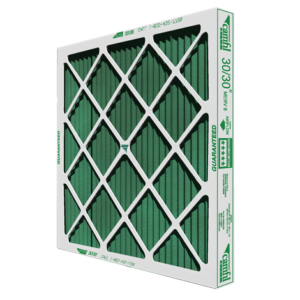
Performing at MERV 8/8A and ePM10 under ASHRAE and ISO filter testing standards respectively, the Farr 30/30 media is manufactured from a proprietary blend of fibers that uses a mechanical particle capture principle, which does not require an electret charge. The electret charge of the competitors’ coarse fiber filters dissipates over time resulting an earlier high-pressure drop and loss of efficiency long before what should be a full life cycle. The Farr 30/30 is guaranteed to 2.0″ w.g. of pressure filter without failure. Costly filter blowouts and compromised cleanliness of HVAC systems is dramatically reduced if not eliminated.
The Farr 30/30 ® upgraded features
- High lofted media, it is twice as thick as similar filters. The media is lofted to a uniform depth to enhance the depth-loading characteristic and ensure the longest life of any pleated filter available. The high-loft also offers a lower resistance to airflow so fan horsepower required to move air through the filter is minimized.
- Radial pleats, this exclusive design feature allows the Farr 30/30® filter to expose all of the media to the dirty airstream which provides a lower pressure drop and higher dirt holding capacity.
- Welded wire grid provides complete media support and maintains pleat configuration as filter airflow resistance increases, this means it’s built to withstand the toughest airflow conditions
- The high wet-strength beverage frame and welded wire media backing provide structural integrity in any type of HVAC application virtually eliminating the additional costs associated with filter bypass or filter failure
- Every 30/30® filter is identified on the frame with a unique manufacturing code that allows us to analyze every component of construction from raw materials to the point where the product is boxed for shipping. Filters are inspected for structural integrity so they are capable of operating in the harshest HVAC system conditions. The adhesiveness of diagonal support members to pleat apexes is inspected so pleat spacing is uniform to provide longer filter life. Each media lot is laboratory tested to confirm consistent performance and individual filters are submitted from each manufacturing facility on a strict schedule for ASHRAE 52.2 testing in our world-class testing facility, this conforms to the ISO 9001:2015 certification for Quality Control.
- Energy Cost Index (ECI) of 5 Stars, ECI compares filters of similar construction, under the same conditions of operation and provides an indicator of TRUE performance. Specifically, the formula is dollars per percent of filter efficiency. The lower the value, the better the filter. A filter with an ECI of five stars is a stellar performer. It maintains its efficiency over its life and uses less energy to move air through the filter. It is in the top 20% of all filters evaluated. A four-star filter has a lower ECI value, and the pattern continues down to one star, the poorest performers.
- Guaranteed to perform at the rated efficiency, or better, throughout the life of the filter.
- We guarantee that Camfil 5-Star Premium Filters will substantially reduce HVAC-related energy consumption, require less frequent change-outs, and reduce waste and environmental impact. We’re the only air filtration company that guarantees our product performance. Look for the Camfil guarantee logo and 5-Star rating.
Filter changes: Recommend changing the filter at least once every other month.
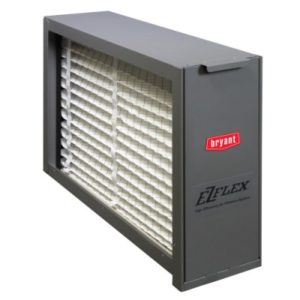
The EZ Flex performs at MERV 10 under ASHRAE 52.2. It has low airflow resistance and does not produce a significant pressure drop. The high dust holding capacity allows for extended times between filter changes.
Filter changes: Recommend changing the filter at least twice per year.
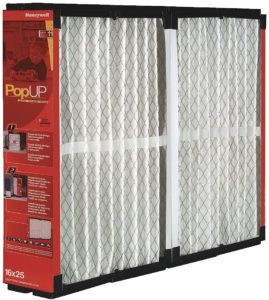
The Honeywell PopUP performs at MERV 11 under ASHRAE 52.2. It has low airflow resistance and does not produce a significant pressure drop. The high dust holding capacity allows for extended times between filter changes.
MERV 11 Honeywell Pop Up Filter fits other media air cleaner cabinets as well, such as Aprilaire, Bryant, and Carrier.
Honeywell Pop Up features
- No Assembly Required – No combs, pleat spacers or end caps. Filter simply pops up and is ready to use.
- Homeowner Friendly Self-Assembly – Open package and POP! The filter is ready to install.
- Collapsible Design – Less chance of damage and makes for easy, clean disposal.
- Meets American Lung Association Health House Guidelines – Fiberglass Free!
- Extra Filtration – the Pop-up design offers an additional 1 inch of depth compared to standard cartridge replacements
Filter Changes: Recommend changing the filter at least twice per year.
Bryant® Air Purifiers are great for homeowners with allergy concerns, individuals susceptible to airborne germs such as infants and the elderly, and those with sensitivity to the effects of pollen, pets and more. Compared to many portable air cleaners, the Evolution Air Purifier is silent and can treat 100% of the air flowing through your home comfort system. The patented Captures & Kills® technology provides a 99% inactivation rate against select viruses and bacteria.* No cleaning required. Simply remove and replace the filter cartridge periodically to maintain peak performance.
How do they work?
- Step 1: The Evolution Air Purifier uses precision point ionization to charge particles as they enter the purifier.
- Step 2: A specially designed, continuously charged media filter captures airborne particles.
- Step 3: Patented, state-of-the-art technology kills select captured viruses and bacteria* and can prevent further growth of organisms on the filter
Filter changes: Recommend changing the filter and cleaning the ionization array at least twice per year.
HEPA (High Efficiency Particulate Air) filters must be tested and must achieve removal of 99.97% of particles down to a submicron level in the air. There are filters designed to remove 99.9999% of particulars as well. HEPA filters are used in a mainly commercial setting. Healthcare facilities, educational facilities, industrial, museums, libraries, hotels, airports, and other commercial, industrial, and medical facilities are some examples of locations that might use HEPA filtration. They are generally not recommended in residential settings. A residential setting would have to have their system designed to be HEPA or a least a costly modification of their current system including the furnace and ductwork to accommodate a true HEPA filter installation. Beware any product claiming “True HEPA”, “HEPA-type”, “99% HEPA” as they do not meet the HEPA standard for testing.
| Merv Rating Standard 522 | .03-1 Micron Removal Rate | 1-3 Micron Removal Rate | 3-10 Micron Removal Rate | Filter type commonly offered by Hauck Bros., Inc. |
| Merv 3 | - | - | under 20% | Washable or Fiberglass |
| Merv 8 | - | - | at least 70% | Pleated or Media Panel |
| Merv 10 | - | 50% - 65% | at least 85% | Media Panel or Rigid Box/Cell |
| Merv 11 | - | 65% - 79% | at least 85% | Media Panel or Rigid Box/Cell |
| Merv 12 | - | 80% - 89.9% | at least 90% | Media Panel or Rigid Box/Cell |
| Merv 14 | 75% - 85% | at least 90% | at least 90% | Rigid Cell/Box or Pocket Filter |
| Merv 16 | at least 95% | at least 95 % | at least 90% | Rigid Cell/Box or Pocket Filter |
| HEPA | at least 99.97% | at least 99.97% | at least 99.97% | Pleated Mechanical |
| Micron Size | ||||||
| under .3 | Viruses | Smog | Carbon Dust | Pesticides | Oil Mist | Asbestos Particles |
| .3 - 1 | Bacteria | Tobacco Smoke | Humidifier Dust | Talcum Dust | Cooking Smoke | Typical Dust |
| 1 - 3 | Milled Flour | Pet Dander | Auto Emmissions | Sneeze Droplets | Legionella | Germs |
| 3 - 10 | Mold Spores | Dust Mites Debris | Pudding Mix | Cement Dust | Hair Spray | Mist |
| 10+ | Hair | Lint | Sawdust | Pollen | Textile Fibers | Carpet Fibers |

